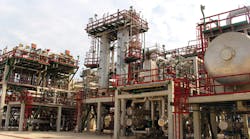Much of the US has experienced unrelenting cold weather during January and February. The winter weather increased demand for space heating fuels and upset crude oil and natural gas production as well as refinery operations, pipelines, and railways. Because of these hindrances, the nation's energy infrastructure had been tested to deliver much-needed fuel to demanding markets.
The demand for distillate, propane, and natural gas increased considerably caused by these colder-than-normal temperatures. Electric power plants in the US Northeast were switching to residual and distillate fuels to replace the limited supply of—and higher-priced—natural gas.
According to the US Energy Information Administration, residual fuel consumption in the US jumped from an average of 220,000 b/d during December and early January to 471,000 b/d in mid-January. Distillate fuel consumption rose 50% to 4.5 million b/d from weeks ended Jan. 3 and Jan. 24. As temperatures eased, average consumption dropped during a 4-week period to 3.6 million b/d as of Feb. 28 (see OGJ's US Industry Scoreboard) and down 4.3% from a year ago for the same 4-week period.
Propane inventories in the Midwest, before heating season even began, were low due to the large, wet corn harvest. Propane is used to "dry" the corn before it can be stored as well as processed at corn mills. The below-normal propane inventories and the arctic temperatures that the Midwest has experienced thus far, caused a large reduction in propane availability to supply Midwest markets.
EIA quoted for Jan. 27, residential propane prices spiked to $4.01/gal and US wholesale/resale price rose to $2.705/gal on Feb. 3. After temperatures moderated and additional emergency propane supplies moved to the Midwest, prices are declining. As of Mar. 3, residential prices have dropped 17% to $3.302/gal and wholesale prices dramatically decreased by 44% to $1.508/gal since the price spike.
E&P issues
In addition to high demand for heating fuels, crude oil and natural gas production was hampered due to the harsh temperatures. EIA's February Short-Term Energy Outlook expected well completion activity to decline, slowing production down with it.
Extreme cold conditions warrant additional equipment at drill sites, hindering the pace of drilling and completing wells. Heating units are required to warm the large amounts of water used for hydraulic fracturing to avoid freezing. Large amounts of snow impede the movement of the drilling equipment on poor road conditions. North Dakota's Department of Mineral Resources stated their state's oil production dropped from 976,000 b/d in November to 923,000 b/d in December. This was the only time the state reported a decline in production for more than a year.
Refineries, transportation
Many refineries had to reduce refinery runs and halt operations due to power outages and the physical effect of the cold on operating units. Utilization rates in the Midwest had been running around 94%, but dropped to 87% for the week of Jan. 17. East Coast utilization rate sank to a low of 70% for the same week, due to the cold weather and planned maintenance. Though the Gulf Coast region did experience unusually lower temperatures, refining operations were not affected as noteworthy as PADD 1 and 2.
Transportation had obstacles to overcome due to extreme weather conditions as well. The upper Midwest railways had challenges with snow and extreme cold; the New York Harbor, where vessel unloading was delayed due to snow, ice, and cold; tanker trucks with deliveries of petroleum products and propane were stalled; and ethanol pipelines froze in the Midwest due to subzero temperatures. Also, storms and fog briefly closed the Houston Ship Channel, which links many Gulf Coast refineries and terminals to the Gulf of Mexico.
Many in the US are starting to unthaw from this miserable cold, but will it last? The National Oceanic and Atmospheric Administration called for cold temperatures to continue through an extensive part of the US East and Midwest for parts of this month.
